Dual-Polarization Radar Observations of the Evolution of a Supercell Tornado and Analysis of the Echo Mechanisms
Abstract
:1. Introduction
2. Data, Methodology and Study Area
3. Synoptic and Mesoscale Environment
3.1. Synoptic Conditions and Disaster Description
3.2. Diagnosis of Local Atmospheric Physical Parameters
3.3. Wind Vector–Potential Temperature (V–3θ) Plots
4. Echo Characteristics and Structural Evolution of the Supercell
4.1. Mechanism of Interaction between Convective Storms during Mergers
4.2. Evolutionary Characteristics of SW
5. Dual-Polarization Signatures of the Supercell Tornado
6. Discussion
7. Conclusions
- The extremely cold tropopause temperatures and high surface temperatures produced a high temperature gradient along the vertical profile. The updraft by upper divergence and vertical thermal instability in the atmosphere over Suzhou collectively promoted the formation and development of convection. In addition, the low LCL and strong lower-level (0–1 km) vertical wind shear provided propitious conditions for tornadogenesis.
- In this case, based on the analysis of the mergers and interactive mechanisms of convective storms, a schematic is developed to describe the mergers of storm cells of this type. Each of the three storm-cell mergers were associated with an increase in the echo intensity, vertical ascending velocity, and vertical vorticity of the storm cell. During the last merger, the merging of the two vortices resulted in the reduction in the rotation radius of the new vortex, which also provided a favorable condition for tornadogenesis. The characteristics of SW were indicative of the formation and evolution of the tornado.
- The dual-polarization signatures at the mature stage of the tornado are analyzed. A notable TDS and ZDR arc can be observed in the PPI scans, while a distinct TVS is visible in the PPI scan of Vr. In addition, an inflow signature is present.
Author Contributions
Funding
Institutional Review Board Statement
Informed Consent Statement
Data Availability Statement
Conflicts of Interest
References
- Davies-Jones, R.; Trapp, R.J.; Bluestein, H.B. Tornadoes and Tornadic Storms. Meteorol. Monogr. 2001, 50, 167–222. [Google Scholar] [CrossRef]
- Johns, R.H.; Doswell, C.A. Severe Local Storms Forecasting. Weather Forecast. 1992, 7, 588–612. [Google Scholar] [CrossRef] [Green Version]
- Moller, A.R. Severe Local Storms Forecasting. Meteorol. Monogr. 2001, 28, 433–480. [Google Scholar] [CrossRef]
- Van Den Broeke, M.S. Polarimetric Radar Metrics Related to Tornado Life Cycles and Intensity in Supercell Storms. Mon. Weather Rev. 2017, 145, 3671–3686. [Google Scholar] [CrossRef]
- Lemon, L.R.; Doswell, C.A. Severe Thunderstorm Evolution and Mesocyclone Structure as Related to Tornadogenesis. Mon. Weather Rev. 1979, 107, 1184–1197. [Google Scholar] [CrossRef]
- Carbone, R.E.; Carpenter, M.J.; Burghart, C.D. Doppler Radar Sampling Limitations in Convective Storms. J. Atmos. Oceanic Technol. 1985, 2, 357–361. [Google Scholar] [CrossRef] [Green Version]
- Bluestein, H.B.; Weiss, C.C.; Pazmany, A.L. Mobile Doppler Radar Observations of a Tornado in a Supercell near Bassett, Nebraska, on 5 June 1999. Part I: Tornadogenesis. Mon. Weather Rev. 2003, 131, 2954–2967. [Google Scholar] [CrossRef]
- Trapp, R.J.; Mitchell, E.D.; Tipton, G.A.; Effertz, D.W.; Watson, A.I.; Andra, D.L.; Magsig, M.A. Descending and nondescending tornadic vortex signatures detected by WSR-88Ds. Weather Forecast. 1999, 14, 625–639. [Google Scholar] [CrossRef]
- Markowski, P.M.; Straka, J.M.; Rasmussen, E.N. Direct surface thermodynamic observations within the rear-flank downdrafts of nontornadic and tornadic supercells. Mon. Weather Rev. 2002, 130, 1692–1721. [Google Scholar] [CrossRef]
- Michael, M.F.; Bluestein, H.B.; Dowell, D.C.; Wicker, L.J.; Kramar, M.R.; Pazmany, A.L. High-Resolution, Mobile Doppler Radar Observations of Cyclic Mesocyclogenesis in a Supercell. Mon. Weather Rev. 2008, 136, 4997–5016. [Google Scholar] [CrossRef] [Green Version]
- Tanamachi, R.L.; Heinselman, P.L.; Wicker, L.J. Impacts of a Storm Merger on the 24 May 2011 El Reno, Oklahoma, Tornadic Supercell. Weather Forecast. 2015, 30, 501–524. [Google Scholar] [CrossRef]
- Tanamachi, R.L.; Heinselman, P.L. Rapid-Scan, Polarimetric Observations of Central Oklahoma Severe Storms on 31 May 2013. Weather Forecast. 2016, 31, 19–42. [Google Scholar] [CrossRef]
- Wurman, J.; Richardson, Y.; Alexander, C.; Weygandt, S.; Zhang, P.F. Dual-Doppler and Single-Doppler Analysis of a Tornadic Storm Undergoing Mergers and Repeated Tornadogenesis. Mon. Weather Rev. 2007, 135, 736–758. [Google Scholar] [CrossRef]
- Kurdzo, J.M.; Bodine, D.J.; Cheong, B.L.; Palmer, R.D. High-Temporal Resolution Polarimetric X-Band Doppler Radar Observations of the 20 May 2013 Moore, Oklahoma, Tornado. Mon. Weather Rev. 2015, 143, 2711–2735. [Google Scholar] [CrossRef] [Green Version]
- Li, Z.C.; Zhu, J.J.; Zhang, C.A.; Sun, J.; Wang, Y. Analysis of Dual Polarization Radar Detection of Tornado Typhoon Rainband in Danzhou and Tunchang in Hainan Province. Meteor. Mon. 2021, 47, 1086–1098. (In Chinese) [Google Scholar] [CrossRef]
- Zhu, J.S.; Liu, J.; Bian, Z.; Fu, C.J. Analysis of cell merger and vortex signature during generation of tornado in Anhui based on Doppler radar observation. Meteor. Mon. 2015, 41, 182–191. (In Chinese) [Google Scholar] [CrossRef]
- Lee, B.D.; Jewett, B.F.; Wilhelmson, R.B. The 19 April 1996 Illinois Tornado Outbreak. Part I: Cell Evolution and Supercell Isolation. Weather Forecast. 2006, 21, 433–448. [Google Scholar] [CrossRef]
- Lee, B.D.; Jewett, B.F.; Wilhelmson, R.B. The 19 April 1996 Illinois Tornado Outbreak. Part II: Cell Mergers and Associated Tornado Incidence. Weather Forecast. 2006, 21, 449–464. [Google Scholar] [CrossRef]
- Lindsey, D.T.; Bunkers, M.J. Observations of a Severe, Left-Moving Supercell on 4 May 2003. Weather Forecast. 2005, 20, 15–22. [Google Scholar] [CrossRef] [Green Version]
- Van Den Broeke, M. Polarimetric Radar Characteristics of Tornadogenesis Failure in Supercell Thunderstorms. Atmosphere 2021, 12, 581. [Google Scholar] [CrossRef]
- Westcott, N.E.; Kennedy, P.C. Cell Development and Merger in an Illinois Thunderstorm Observed by Doppler Radar. J. Atmos. Sci. 1989, 46, 117–131. [Google Scholar] [CrossRef] [Green Version]
- Simpson, J. Downdrafts as Linkages in Dynamic Cumulus Seeding Effects. J. Appl. Meteorol. Climatol. 1980, 19, 477–487. [Google Scholar] [CrossRef] [Green Version]
- Tao, W.-K.; Simpson, J. Cloud Interactions and Merging: Numerical Simulations. J. Atmos. Sci. 1984, 41, 2901–2917. [Google Scholar] [CrossRef] [Green Version]
- Wang, X.M.; Yu, X.D. A study on the physical process involved in the genesis of a severe tropical tornado. Acta Meteorol. Sin. 2019, 77, 387–404. (In Chinese) [Google Scholar] [CrossRef]
- Bluestein, H.B.; Parker, S.S. Modes of Isolated, Severe Convective Storm Formation along the Dryline. Mon. Weather Rev. 1993, 121, 1354–1372. [Google Scholar] [CrossRef] [Green Version]
- Bringi, V.N.; Chandrasekar, V. Polarimetric Doppler Weather Radar: Principles and Applications; Cambridge University Press: Cambridge, UK, 2001. [Google Scholar]
- Kumjian, M.R.; Ryzhkov, A.V. Polarimetric signatures in supercell thunderstorms. J. Appl. Meteorol. Climatol. 2008, 47, 1940–1961. [Google Scholar] [CrossRef]
- Dawson, D.T.; Mansell, E.R.; Jung, Y.; Wicker, L.J.; Kumjian, M.R.; Xue, M. Low-Level ZDR Signatures in Supercell Forward Flanks: The Role of Size Sorting and Melting of Hail. J. Atmos. Sci. 2014, 71, 276–299. [Google Scholar] [CrossRef]
- French, M.M.; Burgess, D.W.; Mansell, E.R.; Wicker, L.J. Bulk Hook Echo Raindrop Sizes Retrieved Using Mobile, Polarimetric Doppler Radar Observations. J. Appl. Meteorol. Climatol. 2015, 54, 423–450. [Google Scholar] [CrossRef]
- Snyder, J.C.; Bluestein, H.B.; Venkatesh, V.; Frasier, S.J. Observations of Polarimetric Signatures in Supercells by an X-Band Mobile Doppler Radar. Mon. Weather Rev. 2013, 141, 3–29. [Google Scholar] [CrossRef]
- Griffin, C.B.; Bodine, D.J.; Palmer, R. Polarimetric Radar Observations of Simultaneous Tornadoes on 10 May 2010 near Norman, Oklahoma. Mon. Weather Rev. 2020, 148, 477–497. [Google Scholar] [CrossRef]
- Ryzhkov, A.V.; Schuur, T.J.; Burgess, D.W.; Zrnic, D.S. Polarimetric Tornado Detection. J. Appl. Meteorol. 2005, 44, 557–570. [Google Scholar] [CrossRef]
- Dawson, D.T.; Mansell, E.R.; Kumjian, M.R. Does Wind Shear Cause Hydrometeor Size Sorting? J. Atmos. Sci. 2015, 72, 340–348. [Google Scholar] [CrossRef]
- Crowe, C.C.; Schultz, C.J.; Kumjian, M.R.; Carey, L.D.; Petersen, W.A. Use of dual-polarization signatures in diagnosing tornadic potential. Electron. J. Oper. Meteorol. 2012, 13, 57–78. [Google Scholar]
- Palmer, R.D.; Bodine, D.; Kumjian, M.; Cheong, B.; Wang, Y. Observations of the 10 may 2010 tornado outbreak using OU-PRIME: Potential for new science with high-resolution polarimetric radar. Bull. Am. Meteorol. Soc. 2011, 92, 871–891. [Google Scholar] [CrossRef] [Green Version]
- Kumjian, M.R.; Ryzhkov, A.V.; Melnikov, V.M.; Schuur, T.J. Rapid-Scan Super-Resolution Observations of a Cyclic Supercell with a Dual-Polarization WSR-88D. Mon. Weather Rev. 2010, 138, 3762–3786. [Google Scholar] [CrossRef]
- Kumjian, M.R.; Khain, A.P.; Benmoshe, N.; Ilotoviz, E.; Ryzhkov, A.V.; Phillips, V.T.J. The Anatomy and Physics of ZDR Columns: Investigating a Polarimetric Radar Signature with a Spectral Bin Microphysical Model. J. Appl. Meteorol. Climatol. 2014, 53, 1820–1843. [Google Scholar] [CrossRef]
- Wilson, M.B.; Van Den Broeke, M.S. An Automated Python Algorithm to Quantify ZDR Arc and KDP–ZDR Separation Signatures in Supercells. J. Atmos. Ocean. Technol. 2021, 38, 371–386. [Google Scholar] [CrossRef]
- Van Den Broeke, M.S. Polarimetric Variability of Classic Supercell Storms as a Function of Environment. J. Appl. Meteorol. Climatol. 2016, 55, 1907–1925. [Google Scholar] [CrossRef]
- Loeffler, S.D.; Kumjian, M.R. Quantifying the Separation of Enhanced ZDR and KDP Regions in Nonsupercell Tornadic Storms. Weather Forecast. 2018, 33, 1143–1157. [Google Scholar] [CrossRef]
- Hersbach, H.; Bell, B.; Berrisford, P.; Biavati, G.; Horányi, A.; Muñoz Sabater, J.; Nicolas, J.; Peubey, C.; Radu, R.; Rozum, I.; et al. ERA5 Hourly Data on Single Levels from 1979 to Present; Copernicus Climate Change Service (C3S) Climate Data Store (CDS): Reading, UK, 2018. [Google Scholar] [CrossRef]
- Zhang, J.; Wang, S.X. An automated 2D multipass Doppler radar velocity dealiasing scheme. J. Atmos. Ocean. Technol. 2006, 23, 1239–1248. [Google Scholar] [CrossRef]
- Shapiro, A.; Potvin, C.K.; Gao, J. Use of a Vertical Vorticity Equation in Variational Dual-Doppler Wind Analysis. J. Atmos. Ocean. Technol. 2008, 26, 2089–2106. [Google Scholar] [CrossRef]
- Potvin, C.K.; Shapiro, A.; Xue, M. Impact of a Vertical Vorticity Constraint in Variational Dual-Doppler Wind Analysis: Tests with Real and Simulated Supercell Data. J. Atmos. Ocean. Technol. 2011, 29, 32–49. [Google Scholar] [CrossRef]
- Protat, A.; Zawadzki, I. A Variational Method for Real-Time Retrieval of Three-Dimensional Wind Field from Multiple-Doppler Bistatic Radar Network Data. J. Atmos. Ocean. Technol. 1999, 16, 432–449. [Google Scholar] [CrossRef]
- Potvin, C.K.; Betten, D.; Wicker, L.J.; Elmore, K.L.; Biggerstaff, M.I. 3DVAR versus Traditional Dual-Doppler Wind Retrievals of a Simulated Supercell Thunderstorm. Mon. Weather Rev. 2012, 140, 3487–3494. [Google Scholar] [CrossRef]
- Potvin, C.K.; Wicker, L.J.; Shapiro, A. Assessing Errors in Variational Dual-Doppler Wind Syntheses of Supercell Thunderstorms Observed by Storm-Scale Mobile Radars. J. Atmos. Ocean. Technol. 2012, 29, 1009–1025. [Google Scholar] [CrossRef]
- Shapiro, A.; Willingham, K.M.; Potvin, C.K. Spatially Variable Advection Correction of Radar Data. Part I: Theoretical Considerations. J. Atmos. Sci. 2010, 67, 3445–3456. [Google Scholar] [CrossRef] [Green Version]
- Shapiro, A.; Willingham, K.M.; Potvin, C.K. Spatially Variable Advection Correction of Radar Data. Part II: Test Results. J. Atmos. Sci. 2010, 67, 3457–3470. [Google Scholar] [CrossRef] [Green Version]
- Craven, J.P.; Brooks, H.E.; Hart, J.A.; Thunder, N. Baseline climatology of sounding derived parameters associated with deep, moist convection. Natl. Wea. Dig. 2004, 28, 13–24. [Google Scholar]
- Thompson, R.L.; Edwards, R.; Hart, J.A.; Elmore, K.L.; Markowski, P. Close Proximity Soundings within Supercell Environments Obtained from the Rapid Update Cycle. Weather Forecast. 2003, 18, 1243. [Google Scholar] [CrossRef] [Green Version]
- OuYang, S.C.; McNeil, D.; Lin, Y. Entering Irregularity; Meteorological Press: Beijing, China, 2002; pp. 219–221. [Google Scholar]
- Bernoulli, D.; Bernoulli, J. Hydrodynamica: Danielis Bernoulli, Hydrodynamica siva de viribus et motibus fluidorum comment arii (1738). Ned. Tijdschr. Voor Nat. 2016, 82, 218–220. [Google Scholar]
- Markowski, P.; Richardson, Y. Mesoscale Meteorology in Midlatitudes; Wiley-Blackwell: West Sussex, UK, 2010; pp. 48–49. [Google Scholar] [CrossRef]
- Fierro, A.O.; Gilmore, M.S.; Mansell, E.R.; Wicker, L.J.; Straka, J.M. Electrification and Lightning in an Idealized Boundary-Crossing Supercell Simulation of 2 June 1995. Mon. Weather Rev. 2006, 134, 3149–3172. [Google Scholar] [CrossRef] [Green Version]
- Lee, B.D.; Finley, C.A.; Karstens, C.D. The Bowdle, South Dakota, Cyclic Tornadic Supercell of 22 May 2010: Surface Analysis of Rear-Flank Downdraft Evolution and Multiple Internal Surges. Mon. Weather Rev. 2012, 140, 3419–3441. [Google Scholar] [CrossRef]
- Hubbert, J.C.; Bringi, V.N. The Effects of Three-Body Scattering on Differential Reflectivity Signatures. J. Atmos. Ocean. Technol. 2000, 17, 51–61. [Google Scholar] [CrossRef] [Green Version]
- Picca, J.; Ryzhkov, A. A Dual-Wavelength Polarimetric Analysis of the 16 May 2010 Oklahoma City Extreme Hailstorm. Mon. Weather Rev. 2012, 140, 1385–1403. [Google Scholar] [CrossRef] [Green Version]
- Wang, B.Y.; Wei, M.; Fan, G.Z.; Du, A.J. The evolution and Mechanism of Tornadic Supercells in the Outer Rainbands of Strong Typhoon Mujigae (1522). Part I: Spectrum width and mesocyclone speed. J. Trop. Meteorol. 2018, 34, 472–480. (In Chinese) [Google Scholar] [CrossRef]
- Kessler, E. Thunderstorm Morphology and Dynamics; University of Oklahoma Press: Norman, OK, USA, 1986. [Google Scholar]
- Ryzhkov, A.V.; Zrni´c, D. Radar Polarimetry for Weather Observations; Springer International Publishing: Cham, Switzerland, 2019; p. 292. [Google Scholar] [CrossRef]
- Lee, R.R.; White, A. Improvement of the WSR-88D Mesocyclone Algorithm. Weather Forecast. 1998, 13, 341–351. [Google Scholar] [CrossRef]
- Schultz, D.M.; Richardson, Y.P.; Markowski, P.M.; Doswell, C.A. Tornadoes in the Central United States and the “Clash of Air Masses”. Bull. Am. Meteorol. Soc. 2014, 95, 1704–1712. [Google Scholar] [CrossRef] [Green Version]
- Trapp, R.J.; Weisman, M.L. Low-Level Mesovortices within Squall Lines and Bow Echoes. Part II: Their Genesis and Implications. Mon. Weather Rev. 2003, 131, 2804–2823. [Google Scholar] [CrossRef] [Green Version]
- Wang, C.; Wei, M. Analysis of Formation Mechanism and Echo Evolution of Gaoyou Tornado on 12 June 2020 in Northern Jiangsu. J. Trop. Meteorol. 2021, 37, 812–823. (In Chinese) [Google Scholar] [CrossRef]

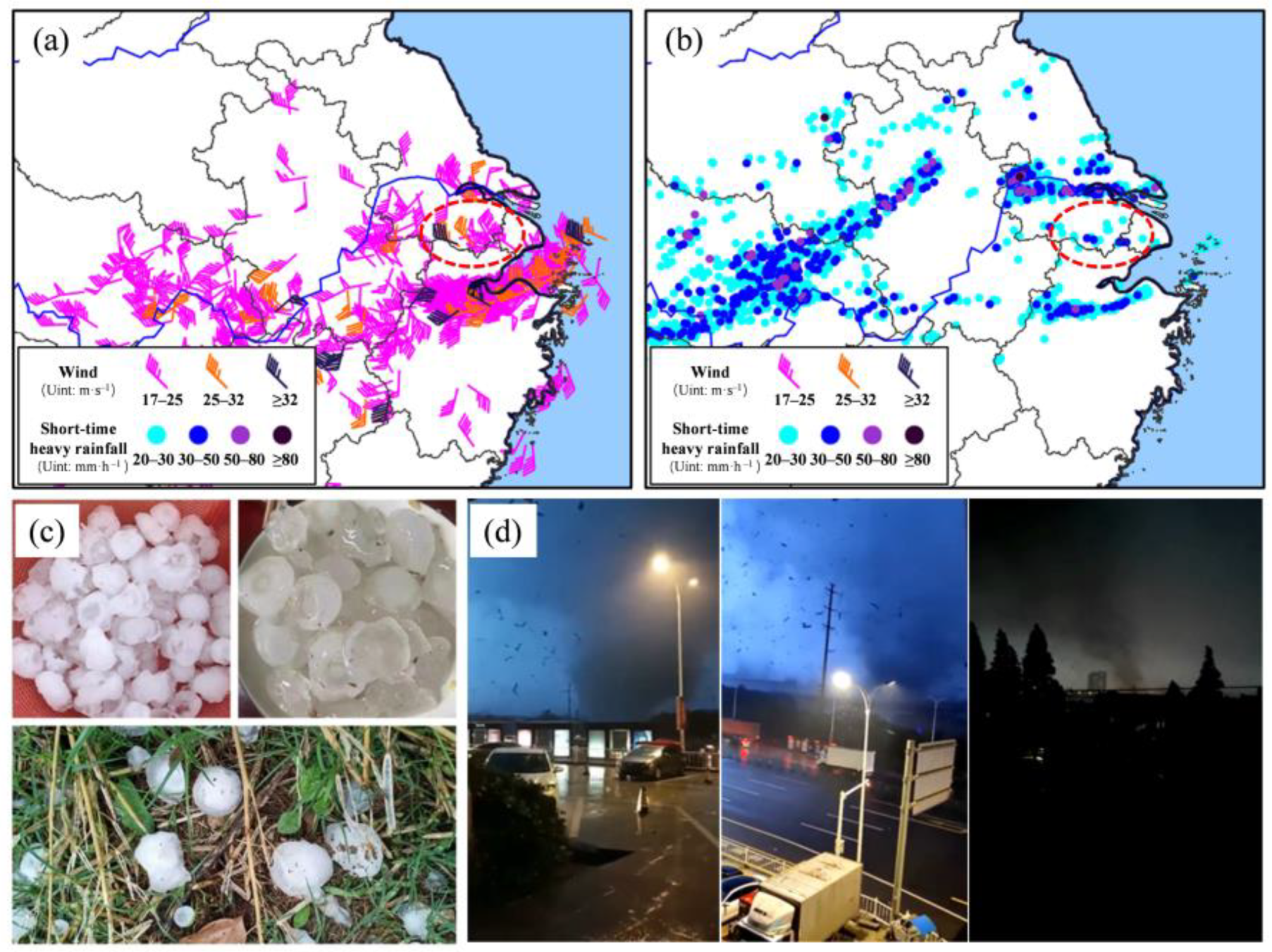


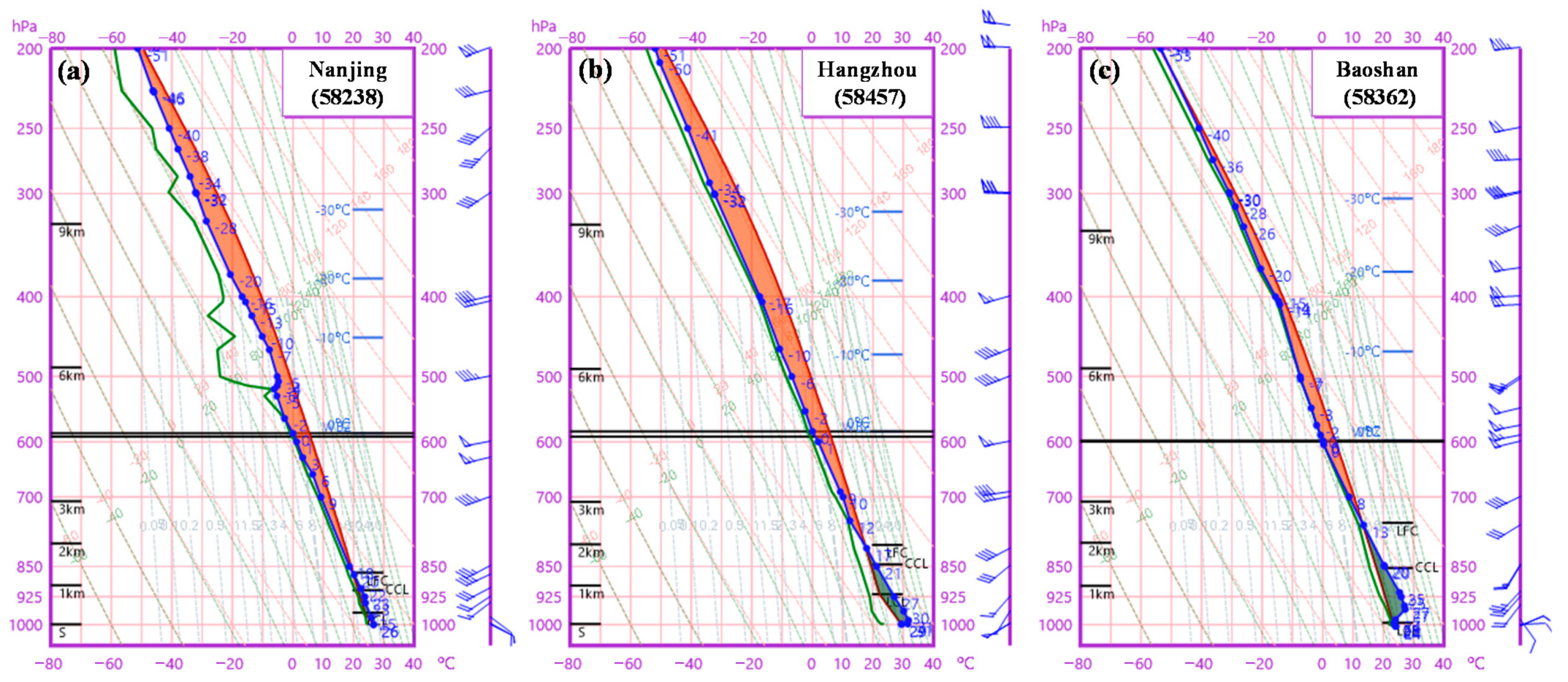


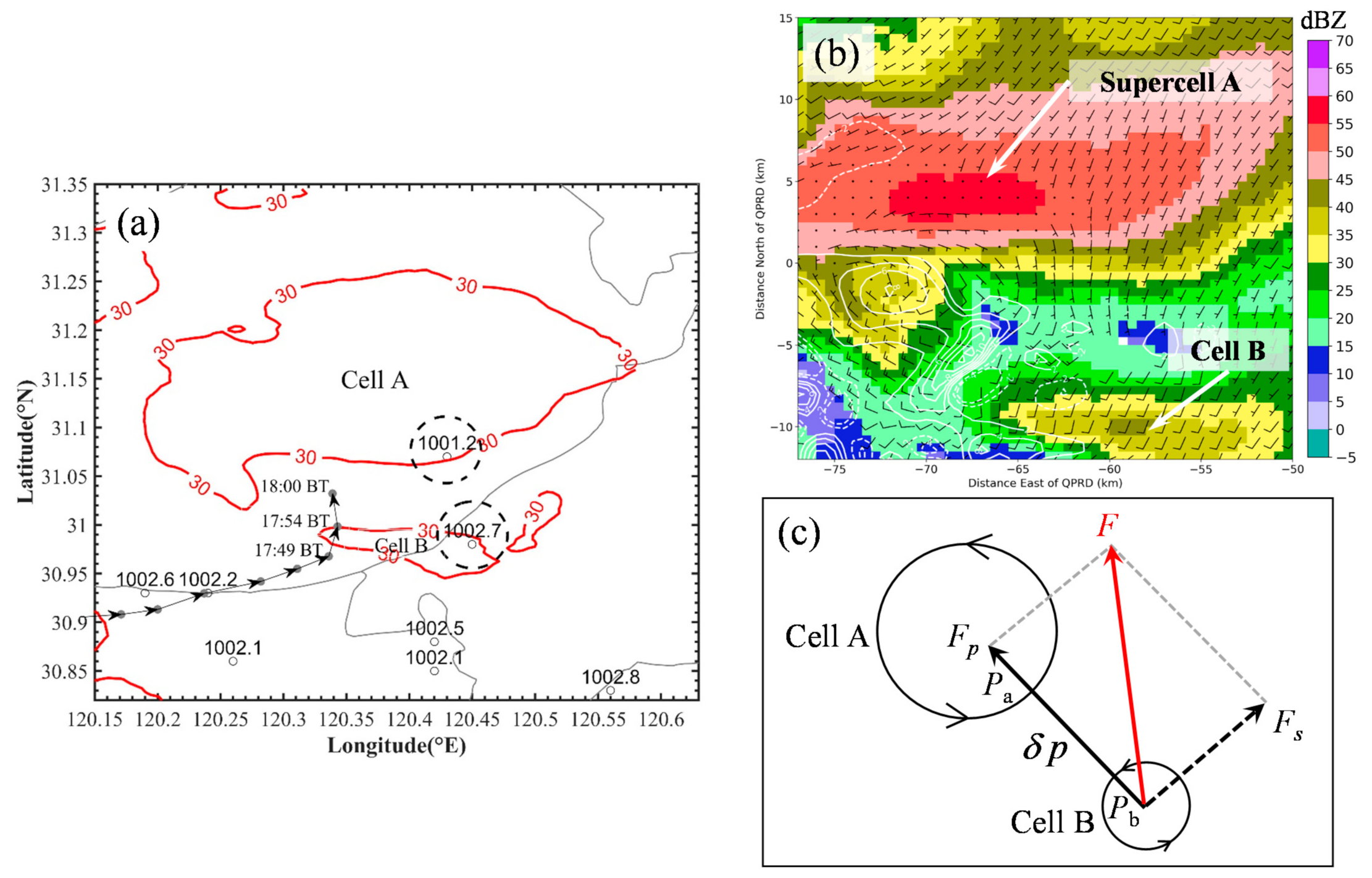

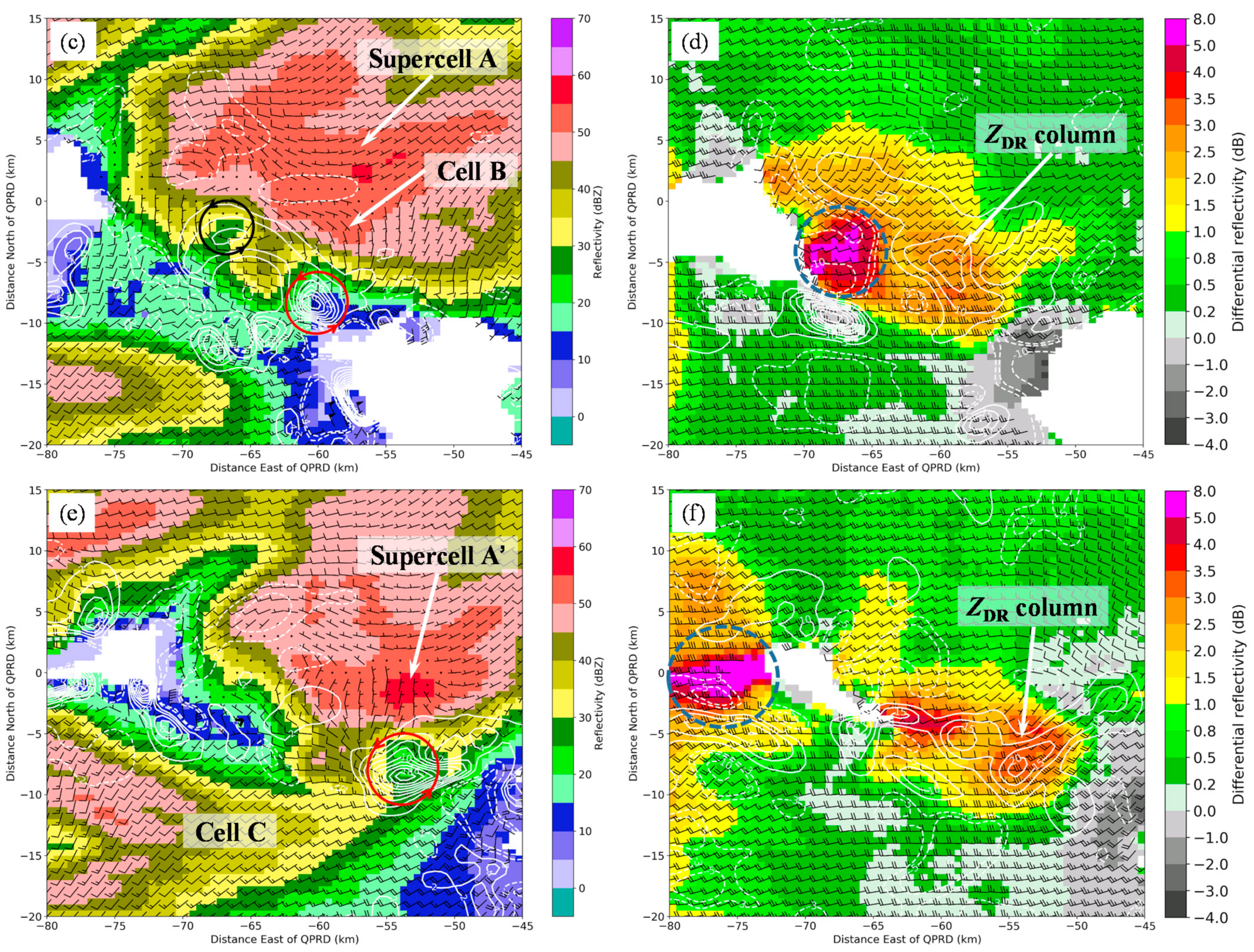
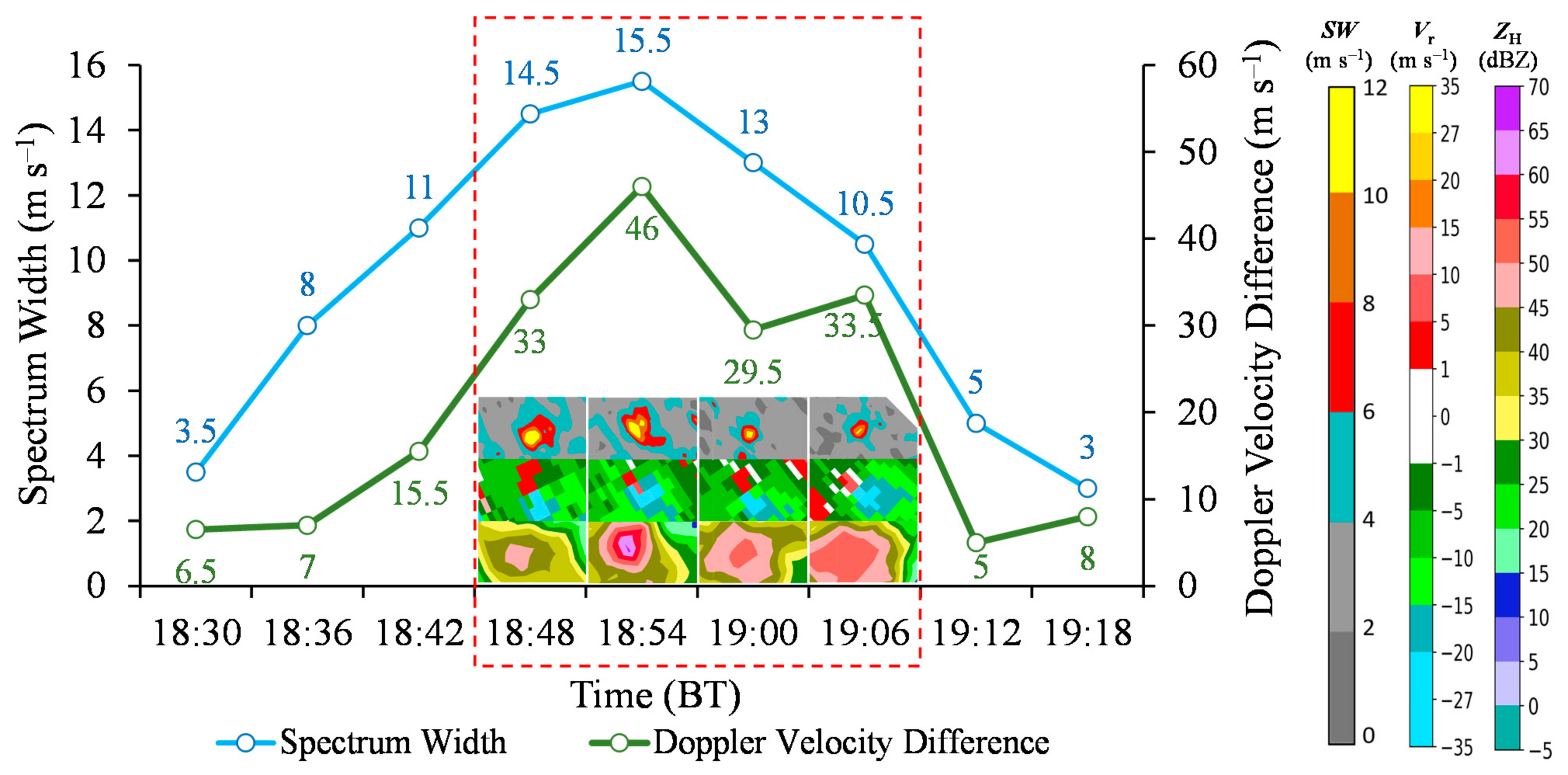

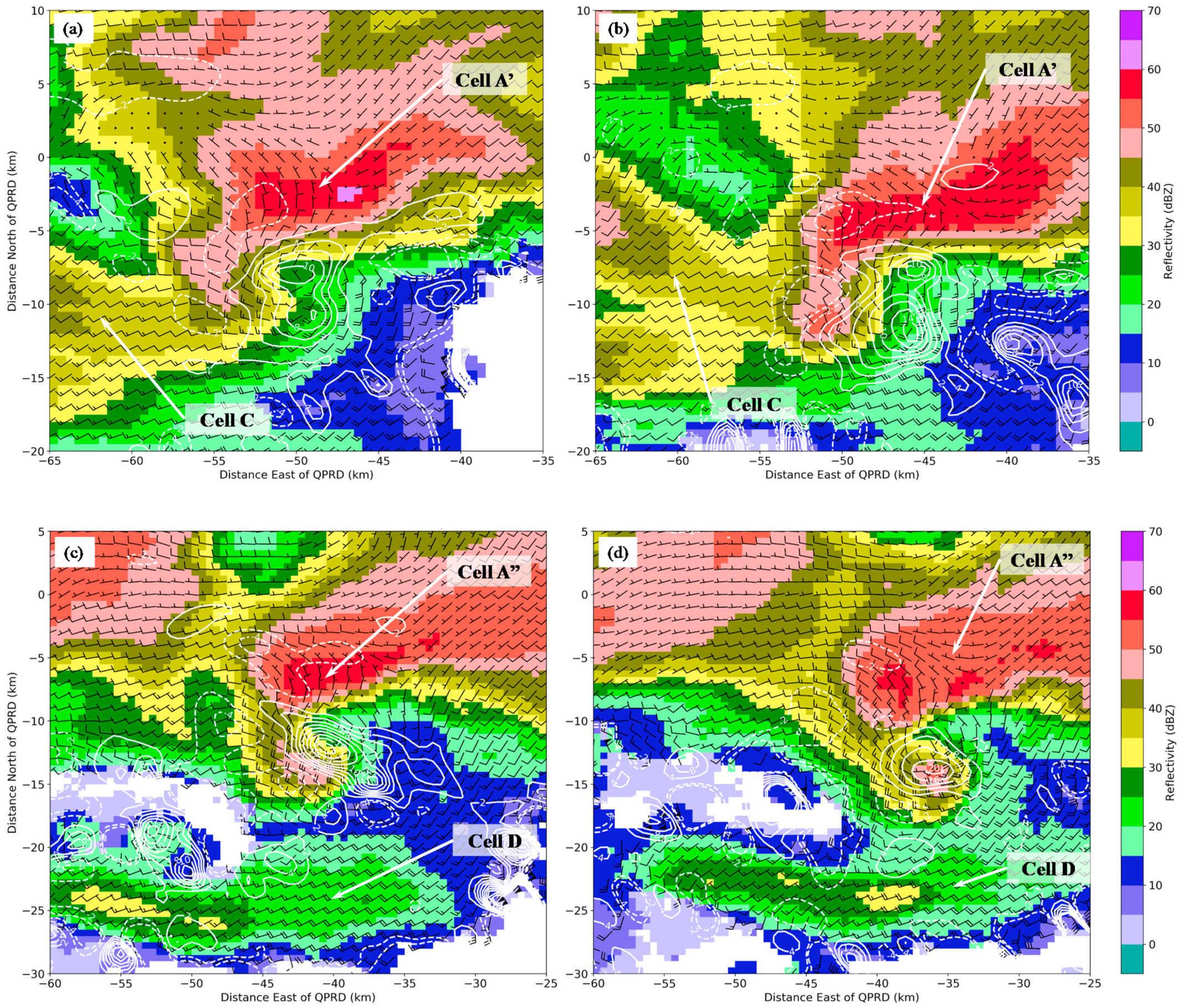
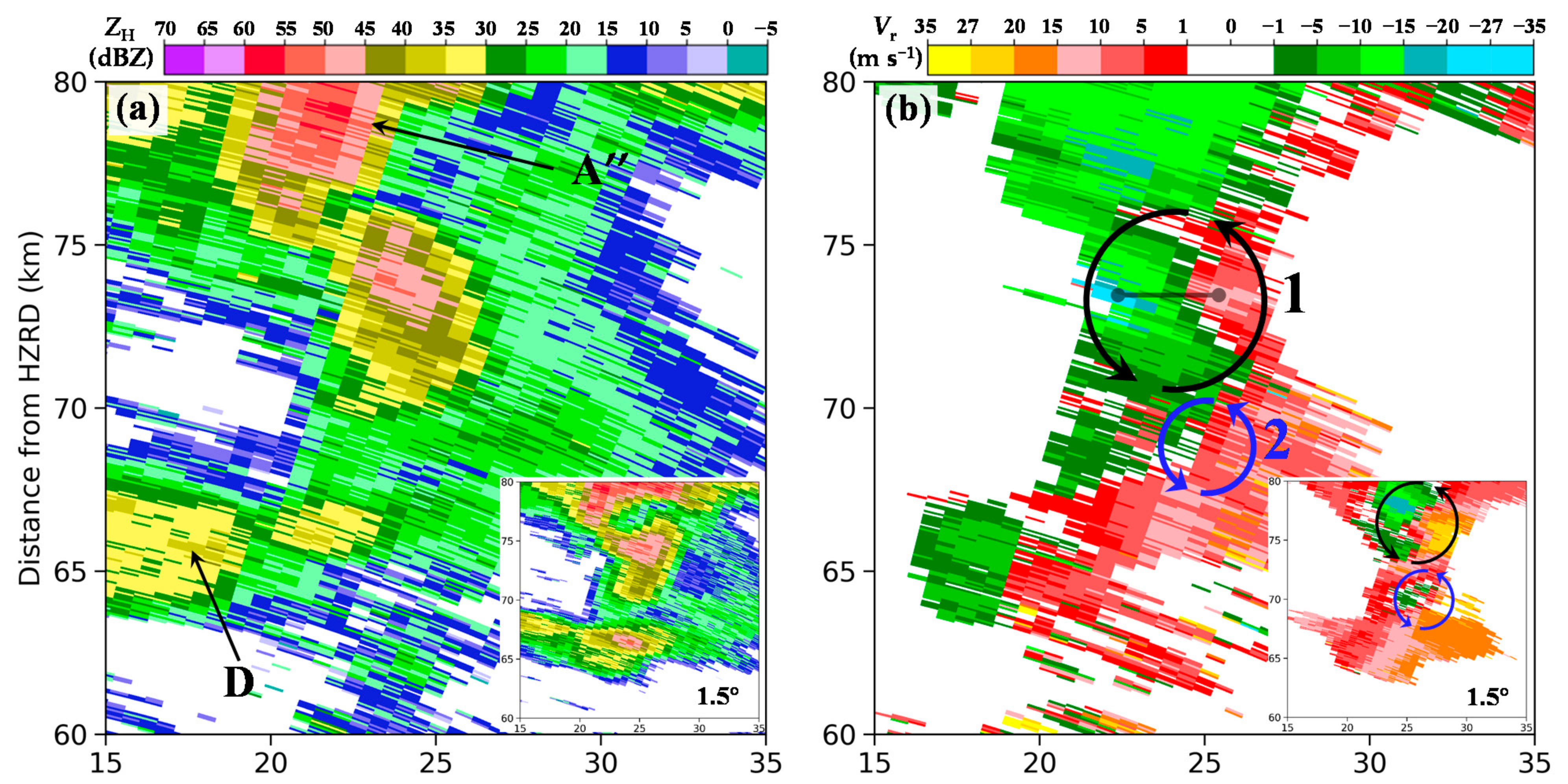

| Environmental Parameter | Hangzhou Station | Nanjing Station | Baoshan Station |
|---|---|---|---|
| CAPE (J kg−1) | 2385.2 | 2056.2 | 895.9 |
| LCL (hPa) | 918.4 | 967 | 994.7 |
| K index (°C) | 41.3 | 40.2 | 42.3 |
| Showalter Index (SI) | −3.46 | −2.21 | −3.34 |
| Storm-relative helicity (SRH) | 204.5 | 104.6 | 199.7 |
| Best lifting index (BLI) | −6.2 | −4.6 | −5.4 |
| 0–1 km S (m s−1) | 7.7 | 13.9 | 10.9 |
| 0–3 km S (m s−1) | 13.8 | 19.2 | 17.4 |
| 0–6 km S (m s−1) | 16.7 | 19.6 | 23.0 |
Publisher’s Note: MDPI stays neutral with regard to jurisdictional claims in published maps and institutional affiliations. |
© 2022 by the authors. Licensee MDPI, Basel, Switzerland. This article is an open access article distributed under the terms and conditions of the Creative Commons Attribution (CC BY) license (https://creativecommons.org/licenses/by/4.0/).
Share and Cite
Wu, B.; Wei, M.; Li, Y. Dual-Polarization Radar Observations of the Evolution of a Supercell Tornado and Analysis of the Echo Mechanisms. Atmosphere 2022, 13, 797. https://doi.org/10.3390/atmos13050797
Wu B, Wei M, Li Y. Dual-Polarization Radar Observations of the Evolution of a Supercell Tornado and Analysis of the Echo Mechanisms. Atmosphere. 2022; 13(5):797. https://doi.org/10.3390/atmos13050797
Chicago/Turabian StyleWu, Bin, Ming Wei, and Yanfang Li. 2022. "Dual-Polarization Radar Observations of the Evolution of a Supercell Tornado and Analysis of the Echo Mechanisms" Atmosphere 13, no. 5: 797. https://doi.org/10.3390/atmos13050797
APA StyleWu, B., Wei, M., & Li, Y. (2022). Dual-Polarization Radar Observations of the Evolution of a Supercell Tornado and Analysis of the Echo Mechanisms. Atmosphere, 13(5), 797. https://doi.org/10.3390/atmos13050797






